Frequently Asked Questions
(Click the question in the list below to be taken to the answer, then use your browser’s back button to return to this question list.)
- Why is the Eastern Bluebird the New York State bird?
- Why a nest box for bluebirds?
- I just bought a nest box. Where should I place it on my property?
- What can I do about house wrens?
- My nestlings died-What happened?
- Do bluebirds clean out dead babies or un-hatched eggs?
- Are the bluebirds I see in the fall the same as those that nested in my boxes over the summer?
- I opened a nest box the other day and found wasps inside. How can I prevent this and getting stung?
- Should we leave the successful bluebird nests in the nest box for next clutch?
- How do I get rid of house sparrows? The problem is getting worse and I want to stop it.
- Is there ever a seminar or class in New York State on how to band birds properly (safely and humanely)?
- What might be chipping or chewing the nest box hole to make it bigger? How can this be fixed or stopped?
- Why do eggs disappear from a nest?
- Why do I see nest boxes set within 5-12 feet of each other or back to back on the same post?
- What do Eastern Bluebirds eat?
- I opened a nest box this March and found a large accumulation of droppings. What was this from?
- After the nest is built, what is the time schedule which will help me predict when the young will fledge?
- Tree swallows are seen around our nest boxes quite late in March and early April. They seem to harass the bluebirds that have selected a nest box. Should we be concerned about this?
- Since I will be monitoring tree swallows also, what is their nest, hatching and fledging schedule?
- I just built a nest box. Should I paint or stain it?
- When the female has been scared away during egg-laying, how long do you wait before you know she is not returning? More than a week? More than 10 days? An example might be a tree being cut down nearby, not necessarily weather-related.
- What are the winter habits of bluebirds?
- I want to build a nest box to place in my field. Can you provide me with guidance on this?
- Will my last year’s bluebirds return or will they move somewhere else?
- I would like to read more about bluebirds and monitoring nest boxes can you recommend some good books?
Why is the Eastern Bluebird the New York State bird?
When the first settlers arrived the Eastern Bluebird was as numerous as robins are today. This azure bird with the rusty breast” considered by many as the harbinger of spring, was proposed as the state bird in 1928 but, it wasn’t until 1970, when its numbers were down by 92%, that it became the state bird. It was the time when hundreds of people became aware of the bluebird’s plight and began putting up nest boxes. It was a matter of choosing and helping a much loved bird! See the full story here.
Bluebirds are “cavity” nesting birds. They do not nest in open trees. Being “secondary” cavity nesters, they do not make their own cavities but build their nests in natural cavities” such as holes in trees, wooden fence posts or those created by woodpeckers. Loss of natural cavities by dead tree removal and incursion of invasive, competing species of birds (i.e., loss of their habitat) made bluebird survival a matter of providing nest boxes which they readily accepted as nesting sites. (Download NYSBS Nest box plans and Bluebird Nesting Boxes as pdf files.)
I just bought a nest box. Where should I place it on my property? There are ideal placement recommendations for nest boxes for bluebirds. Bearing in mind that during the breeding season, bluebirds require 2-25 acres of territory that they will defend from other bluebirds, ideally, placing nest boxes 100 yards apart provides this space. Your yard may be much smaller than this. Adjacent, open property may allow you to have a successful nesting site as long as you place the nest box at least 50 feet out from trees and bushes to discourage house wren intrusion and face it toward a tree 50-100 feet away that the fledglings can fly to. A most important consideration is whether there are house sparrows in your area. In some cases it would be better not to put up a nest box if house sparrows would use it as these invasive, non-native birds destroy bluebird nests and young. Allowing them to nest in your nest box would be damaging to bluebird recovery. (On this site, download the pdf files Getting Started with Bluebirds and How to properly set up your Bluebird Nest Box; Fact Sheet: House Sparrow Control).
What can I do about house wrens?
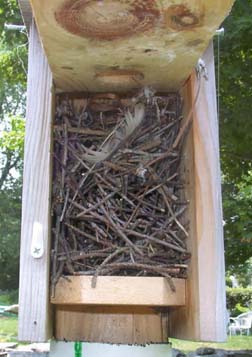
House wrens do not like to fly over long open areas. In most instances placing the nest box at least 50-100 feet and in some cases even further from any bushes and in an open area, you will discourage them from flying to the nest box. They build a readily recognizable stick nest which should be removed from any proposed bluebird nest box as long as the wren nest has no eggs in it. Male house wrens will build false nests in adjacent nest boxes to claim the territory. These can also be removed. Weekly and sometimes more frequent monitoring of those boxes is necessary for wrens can build a nest and lay eggs very quickly. In a situation where the battle seems lost to the wrens, take down your bluebird nest box and place a wren box (1 ¼” opening) at the site. Since house wrens are a native species, in the face of their persistence, having them in the yard singing away is not a bad thing if you can’t get bluebirds!
My nestlings died-What happened?
There are many possible causes of death in nestlings. This is one area where close monitoring of your nest boxes is very important, followed by examination of the nest box and nest after the rest have fledged. Some possible reasons for nestling loss:
- Abandonment by the female (her death or injury) in the first week of life.
- Cold, damp weather which makes it difficult for the adults to procure food for nestlings.
- Predation – by other birds: house sparrows or wrens.
- Poorly constructed nest box allowing either over-heating or freezing or leaks leading to wet nests. (Download the pdf Bluebird Nesting Boxes; NABS nest box specifications)
- Lack of a kerf or kerfs on the inside of the box just below the opening, making it difficult for young to grasp the nest box wall as they attempt to leave box. This is especially important for young tree swallows who have limited grasping power with their claws.
- Disease, heavy parasitism. (Download the pdf Blowflies and Bluebirds).
Do bluebirds clean out dead babies or un-hatched eggs?
Un-hatched eggs are often pushed to the side of the nest or down into it. Dead young may also be pushed to the side. Parents do carry out or consume egg shells of hatchlings as they do with their fecal sacs. Monitoring the nest boxes every 5-7 days will allow you to clean out dead young and help improve the prospects of the remaining live young by removing a source of infection or parasitism. It is best to remove the nest after each fledging is finished. This will remove any source of problems the previous clutch had.
Are the bluebirds I see in the fall the same as those that nested in my boxes over the summer?
Right after fledging the young are fed , then taught to feed on their own by their parents usually in an area near their nest site. They will be seen as family” flocks of 6-8 among the trees near their nest site. Whether bluebirds move away from your area or stay around usually depends on two factors: weather and food availability – or sudden loss of habitat. This really depends on your area of the country. Bluebirds will stay in a breeding area as long as they can procure food (insects in the summer and berries of many sorts in the colder months when insect numbers are down). If the weather turns continually wet and cold, then they will move to areas where they have adequate food and warmth. Males try to stay all winter so they can reclaim their territory early in the spring. You may be visited by bluebirds that arrived from another area on their way to wintering grounds. Unless you can identify them by bands, you can’t tell them from residents.
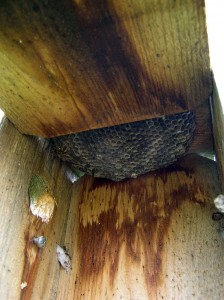 I opened a nest box the other day and found wasps inside. How can I prevent this and getting stung?
I opened a nest box the other day and found wasps inside. How can I prevent this and getting stung?
In the early spring it is not uncommon to see a group of wasps in nest boxes. They usually appear somewhat groggy from the cold. They can be just scraped out of the box with some flat tool. As it gets warmer they may try to build a nest but they are more aggressive then. A quick hand with a spatula can scrape them and the nest out and probably should be attempted at almost dark or on a cool morning when they are somewhat subdued. Using a bar of Ivory soap and rubbing it into the roof of the nest box will make it difficult for the wasps to attach a nest and they will leave. Do not use insecticides. AND – if you are allergic to stings do not attempt this. Get help. The native paper wasp has its place in our ecosystem but not in our nest boxes. The European paper wasp is an alien and much more aggressive. On line sites will help you identify these.
Should we leave the successful bluebird nests in the nest box for next clutch?
When the nestlings have fledged, the nest should be removed, examined for un-hatched eggs, parasites, unusual food items, and then thrown at least 30 feet away from the site so as not to attract predators to the site. Bluebirds can build a nest for a new clutch pretty quickly and it will be healthier for the young – especially if there were parasites. You can learn a lot from a recently vacated nest! In areas where blowflies are found in nests (their pupal cases are found at the bottom of the nest); it is very important to remove and dispose of the nesting material away from the box site. (Download the pdf Blowflies and Bluebirds).
How do I get rid of house sparrows? The problem is getting worse and I want to stop it.
- Thwarting sparrows: In areas where house sparrows are a problem, #6 mono-filament line should be installed on the nest box as prescribed, early in the season before the house sparrow begins selecting its nest box site. This way it does not bond to that nest site and will not enter the box but the earlier nesting bluebird will, in most cases, use the nest box.
- Sparrow Spookers: Placing a frame with hanging Mylar strips on top of the nest box after the first bluebird egg is laid, discourages sparrows from entering the nest box. ( See: Sialis.org.—Sparrow Spookers.)
- Nest Boxes: There is a Gilbertson PVC bluebird nest box which house sparrows do not seem to like to enter. There is also a Troyer Slot Box which house sparrows do not seem to like. These may be tried in lieu of the standard NYSBS or NABS boxes. (See this site: The Gilbertson PVC Nest Box” where you will find plans to build this nest box). Linda Violett of California has developed a 2-holed nest box to reduce house sparrow problems- (See Two-holed Mansion nest boxes.)
- Trapping: Sparrows can be trapped in their box through use of a trap (Universal Sparrow Trap; Van Ert Sparrow trap) which is placed inside the opening of the nest box and is tripped as the sparrow goes into the box. The sparrow can be removed and dispatched. CAUTION: When using these traps, one must be present to remove any other species that enter the box and free them. Since the male house sparrow will bond with the nest box, it is the male you want to be rid of. A wire box-like trap which sits on the ground is also used to catch house sparrows. A male house sparrow caught and placed into the ground trap will call other sparrows into the trap and has been used with great success. (For more details, download the pdfs: A House Sparrow Advisory for Property Owner and Fact Sheet: House Sparrow Control) Finally, some areas are not suitable for putting up nest boxes for bluebirds. Areas around suburban houses, farmsteads and feedlots and old buildings often are very attractive to large house sparrow populations. These then, spill over into the bluebird boxes. It might be wiser to put up house wren boxes which will attract that native bird and because of the smaller opening, keep house sparrows out and prevent them from increasing their population in your area.
Is there ever a seminar or class in New York State on how to band birds properly (safely and humanely)?
The US Fish and Wildlife Service is the agency which issues permits to legally band birds. One must have a USFWS permit to band birds. Two ways to get a permit are 1. To find a permitted bander, observe them and become a sub-permittee under their banding permit. 2. Attend a banding seminar and training: See USFWS.org; also Powdermill.org.
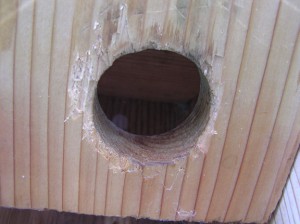
What might be chipping or chewing the nest box hole to make it bigger? How can this be fixed or stopped?
Red-bellied woodpeckers, downy woodpeckers and flying squirrels will try to make the openings larger. A metal plate with a 1 ½” opening can be carefully placed over the opening so it does not restrict the bluebird’s entry and will discourage this chipping.
Why do eggs disappear from a nest?
Predation by house wrens, house sparrows, raccoons, snakes or other bird species are the most likely causes. Have you a predator guard on your nest box pole? (Download the pdf Predator Control.)
Why do I see nest boxes set within 5-12 feet of each other or back to back on the same post?
The second nest box has been placed there because tree swallows, also cavity nesting birds, will nest next to bluebirds and in most instances the two species will both have successful clutches. The bluebird will nest earlier in late March or April and take one of the nest boxes. Tree swallows, even though they don’t nest ‘til mid-May may compete with the bluebirds and harass them early in the season if only one nest box is available. (My experience is that it is happening earlier in each year.) Placing a second paired box seems to work well and we find ourselves monitoring not just bluebirds but, tree swallows also. (Download the pdf Tree Swallows.)
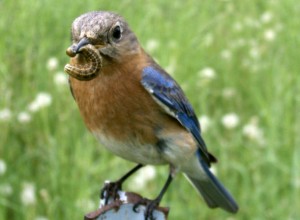
What do Eastern Bluebirds eat?
75% or more of their diet is insects during the months those are available. When insects are not available they eat berries and fruits from trees and bushes such as sumac, bittersweet, bayberry, wineberry, white cedar, holly, dogwood, etc. Black cherry seeds (pits) and ground snail shells have often been seen in their nest after fledging. (Download the pdf Plantings for Eastern Bluebirds)
I opened a nest box this March and found a large accumulation of droppings. What was this from?
Those bluebirds which stay through the winter can get cold just like you or I. Several will pick a nest box as a roosting site and pile in on each other to keep warm and share their body heat. Their droppings will be found at the bottom of the box and by examining them you can tell what they were eating that winter! A helpful hint – plug up any ventilation openings on a roosting box to help retain the heat. It has also been recommended that the door be reversed placing the opening lower on the box so heat, which rises, is retained better. Return the door to its normal position in time for the nesting season.
After the nest is built, what is the time schedule which will help me predict when the young will fledge?
The female bluebird lays 1 egg a day for 4-6 days (4 to 6 eggs). She begins incubating after the last egg is laid. She may take a day off before she incubates but your estimates will be pretty accurate if you begin the count from the day the last egg is laid. Then, the eggs will hatch in 12-14 days, so using 13 days usually works out well. 17 days later they will have fledged – left the nest for that nearby tree you aimed your nest box at about 50-100 feet away where the parents will feed them. BUT – 5 days before the fledge date, we DO NOT open the nest box because we may cause the nestlings to get upset and try to leave the nest before they are fully able to fly to that safe spot in the tree. That is the NO CHECK date. Very important – therefore your math should be good too! An example: Last egg of 5 eggs laid on 4/4. So, 4/4 + 13 days = hatching date 4/17. 17 days to fledging means the fledge date will be 4/34 or 5/4. But, of course, you knew the no check” date was 4/30 – 5 days before the fledge date. The aforementioned hatching and fledging times are an approximation and may require an extra day or so given a cooler/wetter climate or limited food supply.
Tree swallows are seen around our nest boxes quite late in March and early April. They seem to harass the bluebirds that have selected a nest box. Should we be concerned about this?
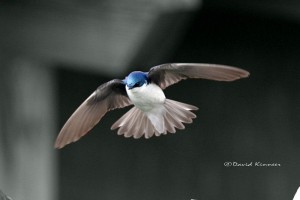
Tree swallows are wonderful birds that are also insectivorous. They weave all over the sky getting their insect meals. They are also secondary cavity nesting birds so they like the nest boxes too. They do not nest and lay eggs until mid- May but, they may claim nest boxes. By putting up a second nest box within 6-12 feet of the first, the tree swallows will have a nest box to nest in and the two species will get along well. There is no serious competition for food, as the bluebirds drop down from a perch and usually grab insects off the ground or close to it. The tree swallows get their insects from the air so the same territory can satisfy both. (Download the pdf Tree Swallows.)
Since I will be monitoring tree swallows also, what is their nest, hatching and fledging schedule?
From the date of the last egg laid, count 14 days to hatching; 20 days more to fledging. No check date (date after which you do not open the nest box until after fledging) is 5 days before the fledge date. Remember that these hatching and fledging times are an approximation and can change with cooler/wetter weather or limited food supply.
I just built a nest box. Should I paint or stain it?
This is a subject that is open to debate. The exterior of the nest box may be painted with a non-toxic paint BUT- unpainted, natural wood, especially cedar, is acceptable and works very well. Pine is a common and inexpensive building material but, if left unpainted does not weather well and the box will have a shorter life. The inside should not be painted. If you do paint, always use a non-toxic (latex) paint and allow at least a week for it to dry and dissipate any odor before putting the box up. Painting the top of the nest box white will help reflect sunlight and reduce heat absorption thus keeping the box cooler.
When the female has been scared away during egg-laying, how long do you wait before you know she is not returning? More than a week? More than 10 days? An example might be a tree being cut down nearby, not necessarily weather-related.
The female Eastern bluebird lays one egg a day – rarely may skip a day. Therefore checking the nest box would tell you whether she came back the next day or not. If the clutch was finished, I would wait 13-14 days to see if the eggs hatch since you may not be there to see when she returns or leaves the nest box. Make sure you have counted the number of days properly and realize they don’t always go by the book”.
What are the winter habits of bluebirds?
Bluebirds do not migrate as we know other birds may migrate. They, in our area, may move to warmer climes where food is more plentiful in times of severe winter weather. We see males throughout the winter as the young and females seem to leave the area and for more southerly areas, although, cameras placed at nesting sites, have recorded birds of the most recent year late into the winter. The bluebirds we see, and there have been more and more seen each year, are seen at the forest edge, around houses, and even on wide open spits of land jutting out into marine bays. In some warmer sections of the country both sexes stay year round and have more clutches. (Download the pdfs Wintering Bluebirds May Need Help and Winter Food For Bluebirds.)
I want to build a nest box to place in my field. Can you provide me with guidance on this?
Download the pdf Bluebird Nesting Boxes for a good discussion and plans for building several types of nest box. It is important to pay attention to details for cutting corners, such as using too thin or poorer quality wood, incorrect entrance hole size and skimping on dimensions and incorrect placement can lead to very unhappy circumstances for the birds you wish to help.
Will my last year’s bluebirds return or will they move somewhere else?
The male Eastern bluebird returns and chooses his prospective nest site (remember, the female makes the final decision!). The adults tend to return to a nest site they have previously used. This is called “philopatry”, – preference for a site in an area they have previously used. It is the site that they return to and not necessarily the nest box that is there. The box itself is not the important factor as bluebirds often will move right in to a replacement nest box. Factors such as the loss of a clutch by predation or weather may cause them to move to another site as will the loss of a mate. A new partner may choose a new site.
I would like to read more about bluebirds and monitoring nest boxes can you recommend some good books?
• Bluebird Trails- a Guide to Success” by Doreen Scriven. A well written, comprehensive and up-to-date discussion of bluebirds.
• Studying Eastern Bluebirds” by Dr. T. David Pitts- many years of interesting and valuable observations.
• The Bluebird Monitor’s Guide”- a Cornell Bird Library Guide- by Berger, Kridler and Griggs.
• The Bluebird Guide” by Don and Lillian Stokes
• Eastern Bluebird”-Wild Bird Guide Series- by Gary Richardson
• Bluebirds” – by Steve Grooms and Dick Peterson
• Bluebirds Forever”- by Connie Toops
• A wonderful classic work by Dr. Lawrence Zeleny—The Bluebird and How You Can Help it’s Fight for Survival”. Out of print but, poke around in old book stores and you may find this gem which lit the fire under the Bluebird conservation movement,
• The North American Bluebird Society and the New York State Bluebird Society and many of the State Bluebird Societies publish Journals or newsletters and much recent information and discussion can be found by reading them.
• will also be available to answer your questions.
• Web-Site: Sialis– an all encompassing guide to bluebird history, natural history, nest boxes, monitoring and more
